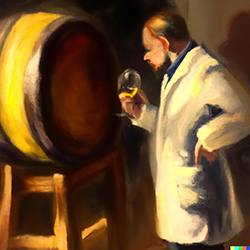Sulfites: Fact Vs. Fiction Part 1
Posted by Matteo Lahm on 8th Jan 2025
The use of sulfites is one of the hottest debates in winemaking. It is such an important topic, it will be addressed in two separate blog posts. Part two will be in your next newsletter. First let’s deal with what sulfites are, where they are found, compare their levels in wine to other foods and clarify what really constitutes a sulfite allergy. It will also confront claims that sulfites cause headaches. Keep reading because you are in for quite a surprise.
Sulfites are compounds consisting of sulfur and oxygen and have been used as a preservative in the winemaking process for centuries. They are essential to produce quality aged wines. Yet today, some winemakers fear and refuse to use them either by virtue of a “purist” approach based on assertions that it is somehow a foreign substance or, that they are unhealthy. While many adhere to these assertions, the facts do not bear them out.
Just by keeping sulfites out of your wine does not mean keeping them out of your diet, or your body. Sulfites are naturally occurring in some foods, as well as being added as preservatives in others.

Sulfites are composed of sulfur dioxide and other sulfur oxides, including sodium bisulfite, potassium metabisulfite, and sodium metabisulfite. They can also be found in sulfates such as ammonium sulfate and sodium sulfate. Sulfites have been used for centuries to preserve food since they act as powerful antimicrobials, preventing the growth of bacteria, yeasts and molds. In addition to this, they also help to prevent oxidation of food products such as fresh fruit or wine by inhibiting enzyme activity.
Despite popular belief, sulfites do occur naturally in many foods. Fruits such as apples or pears contain levels up to 60 parts per million (ppm). Other examples include cured meats such as bacon which can contain up to 800 ppm and dried fruits like raisins which contain up to 1000 ppm. Sulfites are also found in fermented foods like relishes, sauerkraut and vinegar, tomato sauces, onions, garlic, soy and even maple syrup. Sulfites are not only naturally occurring in foods, they are found in soil, water and air, with concentrations typically ranging from 10 to 50 ppm (parts per million). Lastly, the human body produces them naturally through normal cellular and immune function.Therefore, if you woke up this morning, breathed air, drank water, ate bacon and eggs for breakfast, had an apple during lunch, some raisins for an afternoon snack and only got a headache from the glass of wine you had at a restaurant that same evening, it was not from the sulfites. Wine contains levels of up to 350 ppm. This is sufficient for a degree of protection from oxidation processes during storage and less than some of the foods listed.
So far, there is no evidence that links the odious red wine headache to sulfites yet headaches are one of the most commonly reported symptoms associated with red wine consumption. But if the sulfites are not responsible, what is?
One possible explanation that has been proposed is that certain chemical components known as amines, are responsible for triggering these symptoms, not sulfites. Amines are organic compounds that contain nitrogen atoms and can be formed through the breakdown of proteins or other substances present in foods such as red wine. Several studies have examined potential links between amines found in red wines and headache symptoms experienced by some individuals following consumption.
There is another theory that tyramine was significantly higher in cases where individuals experienced headaches compared to those who did not experience any headache symptoms after consuming a glass of red wine. Similarly, increased levels of phenylethylamine in wines which were associated with headache symptoms following consumption. Further studies have also identified other amines which are believed to be associated with red-wine related headaches such as histamine, tannins and polyphenols.

The evidence so far suggests that there may be a link between certain amines found in red wines and headache symptoms experienced by some individuals following consumption. However, it should be noted that this research is still relatively limited in scope and further studies will be needed to confirm or refute these findings before any firm conclusions can be drawn about whether amines are indeed responsible for inducing headache symptoms after drinking red wines. Furthermore, it is important to consider the potential implications that this theory may have for clinical practice if it is ultimately proven correct. For instance, if it can be demonstrated conclusively that certain amines present in red wines are responsible for inducing headache symptoms then this could potentially inform advice given to patients who suffer from recurrent headaches which may have been triggered by excessive consumption of alcoholic beverages containing these compounds. Additionally, it could lead to further investigations into ways to reduce or eliminate these compounds from alcoholic drinks so as to reduce their likelihood of causing adverse reactions among consumers.There is only one other possible cause for wine headaches and they can be remedied with a glass of water. Alcohol dehydrates you. If you get wine headaches, try drinking water on the side. If your headaches subside, you have your answer.
As for sulfite sensitivity, that is legit, but the headache is not on the list of symptoms. They include shortness of breath, skin rashes, digestive distress, dizziness, hives, collapse, tingling and difficulty swallowing. If you get none of these symptoms after putting vinegar on your salad, eating eggs or yogurt with raisins, you are not sensitive to sulfites.
Unless you are prepared to eliminate the long list of foods containing sulfites, there is little if any reason to not use them in your wine. And now for the punchline… If the amine theory is correct, sulfites actually limit amine production. Wines fermented without sulfites contain more. So, if you get red wine headaches, sulfites are not the cause, they just might be the remedy.
Now that you have more background on the science of sulfites, check out our next blog post and find out what horrible things can happen to your wine if you don't use them... and maybe a couple positive things also. Merry Christmas.

